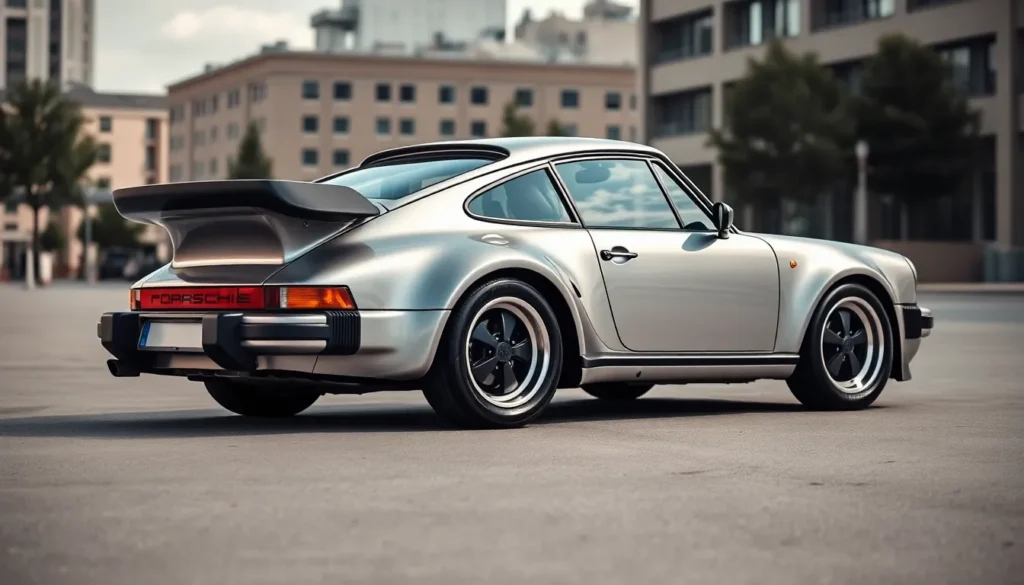The Porsche 930 Turbo stands as one of automotive history’s most legendary and feared sports cars. Known affectionately as the “Widowmaker” for its unpredictable handling characteristics, this iconic machine redefined what performance meant in the 1970s and 1980s. We’re talking about a car that could go from docile cruiser to wild beast in the blink of an eye.
When Porsche unleashed the 930 Turbo in 1975, they didn’t just create another fast car – they birthed a legend that would forever change the supercar industry. This wasn’t your typical sports car; it was a turbocharged monster that demanded respect and rewarded skilled drivers with intoxicating performance.
We’ll explore everything that makes the 930 Turbo so special, from its groundbreaking turbocharger technology to its distinctive whale-tail spoiler. Whether you’re a Porsche enthusiast or simply curious about automotive icons, the 930 Turbo’s story will captivate and inspire you.
What Makes the Porsche 930 Turbo Special
The Porsche 930 Turbo stands apart from its contemporaries through its groundbreaking turbocharged engine technology that delivered unprecedented performance in the mid-1970s. Our examination reveals that this vehicle introduced the first production turbocharged engine in Porsche’s lineup, generating 260 horsepower from its 3.0-liter flat-six engine.
Distinctive visual elements define the 930 Turbo’s iconic appearance and functional design. The famous “whale tail” spoiler extends prominently from the rear deck, providing essential downforce at high speeds while creating the car’s unmistakable silhouette. Wide rear fender flares accommodate the broader Fuchs wheels and Pirelli P7 tires, measuring 205/50VR15 in front and 225/50VR15 in the rear.
Performance capabilities of the 930 Turbo exceeded expectations for sports cars of its era. Acceleration from 0 to 60 mph occurred in just 5.4 seconds, while the top speed reached 155 mph. These figures established the 930 Turbo as one of the fastest production cars available in 1975.
Engineering innovations throughout the 930 Turbo’s development created lasting influence on automotive design. The KKK turbocharger system utilized exhaust gases to compress intake air, dramatically increasing power output without enlarging engine displacement. This technology demonstrated Porsche’s commitment to efficiency and performance optimization.
Exclusivity factors contribute significantly to the 930 Turbo’s special status among collectors and enthusiasts. Production numbers remained limited to 21,589 units worldwide between 1975 and 1989, with only 2,819 examples reaching the United States market during the initial production run from 1976 to 1977.
The 930 Turbo’s handling characteristics earned it the notorious “Widowmaker” nickname due to sudden power delivery and rear-engine weight distribution. Turbo lag created dramatic power surges that required exceptional driving skill to manage effectively, particularly when cornering at speed.
Cultural impact extends beyond automotive circles, establishing the 930 Turbo as a symbol of 1980s excess and performance. Movies, television shows, and popular culture frequently featured this distinctive Porsche model, cementing its place in automotive history and popular consciousness.
Performance and Engine Specifications
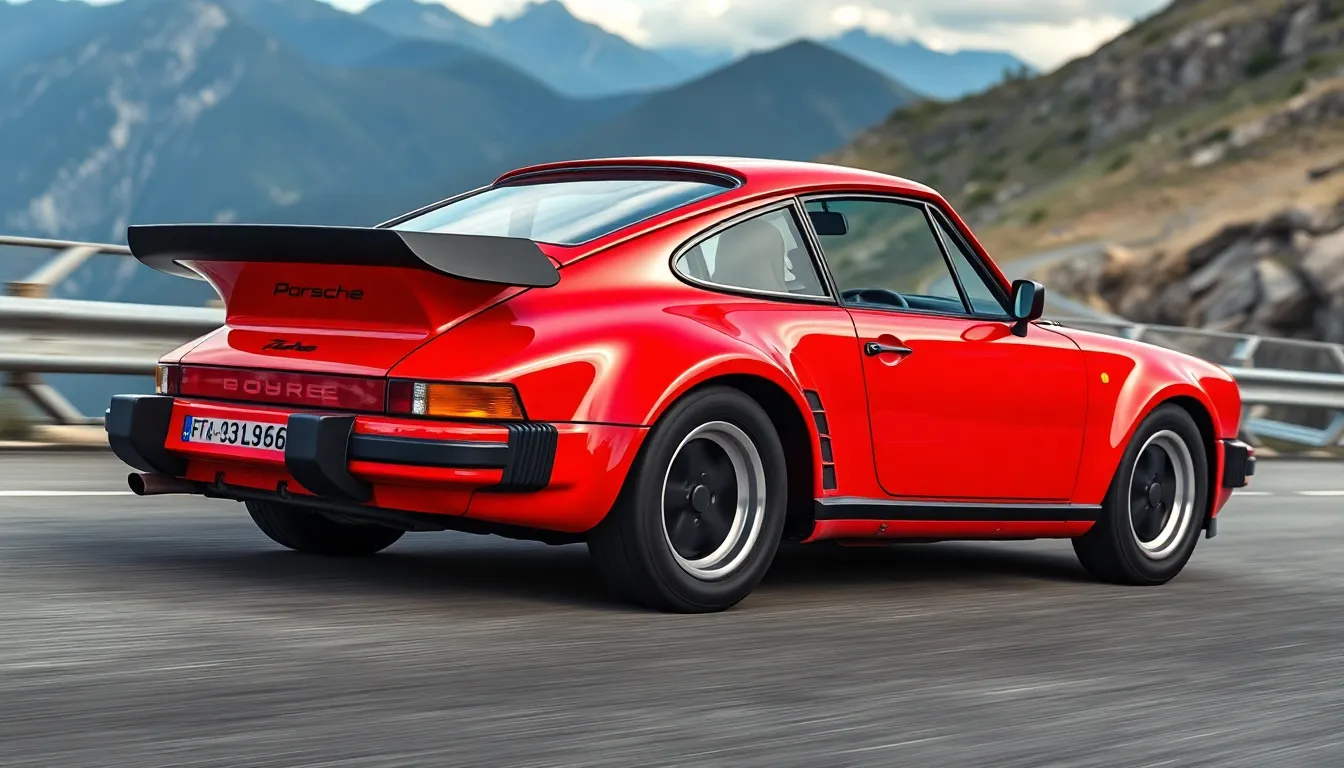
The 930 Turbo’s performance credentials stem from revolutionary engineering that transformed how sports cars deliver power. Raw acceleration figures and unique handling traits define this legendary machine’s driving experience.
Turbo Power and Acceleration
Porsche’s 3.0-liter turbocharged flat-six engine generates 260 horsepower at 5,500 rpm and 254 lb-ft of torque at 4,000 rpm. This powerplant features a KKK K26 turbocharger that creates boost pressure of 0.8 bar, delivering substantial performance gains over naturally aspirated engines of the era.
The 930 Turbo accelerates from 0 to 60 mph in 5.4 seconds and reaches a top speed of 155 mph. Quarter-mile times consistently measure 13.9 seconds at 102 mph, showcasing the vehicle’s straight-line capabilities. Maximum power delivery occurs within a narrow RPM band between 4,000 and 6,000 revolutions per minute.
Turbo lag characteristics define the engine’s personality, with boost pressure building gradually from 3,500 rpm before unleashing full power at 4,000 rpm. This delayed response creates distinctive driving dynamics that separate the 930 from contemporary sports cars.
Handling Characteristics
Weight distribution measures 40% front and 60% rear, placing substantial mass over the drive wheels while creating inherent stability challenges. The rear-mounted engine configuration amplifies this imbalance during aggressive cornering maneuvers.
Suspension components include MacPherson struts at the front and semi-trailing arms at the rear, with Bilstein shock absorbers managing wheel movement. Pirelli P7 tires measuring 205/50 VR15 front and 225/50 VR15 rear provide grip levels that match the era’s performance standards.
Turbo lag combined with rear weight bias creates sudden power transitions that demand precise throttle control. Lift-off oversteer occurs when drivers reduce throttle input mid-corner, causing the rear end to step out unpredictably. These traits earned the 930 its “Widowmaker” reputation among driving enthusiasts and automotive journalists.
Braking performance utilizes ventilated discs measuring 11.1 inches front and 11.8 inches rear, with four-piston calipers managing stopping power. Brake fade resistance remains adequate for spirited driving though extended track sessions expose thermal limitations common to 1970s brake technology.
Design and Styling Features
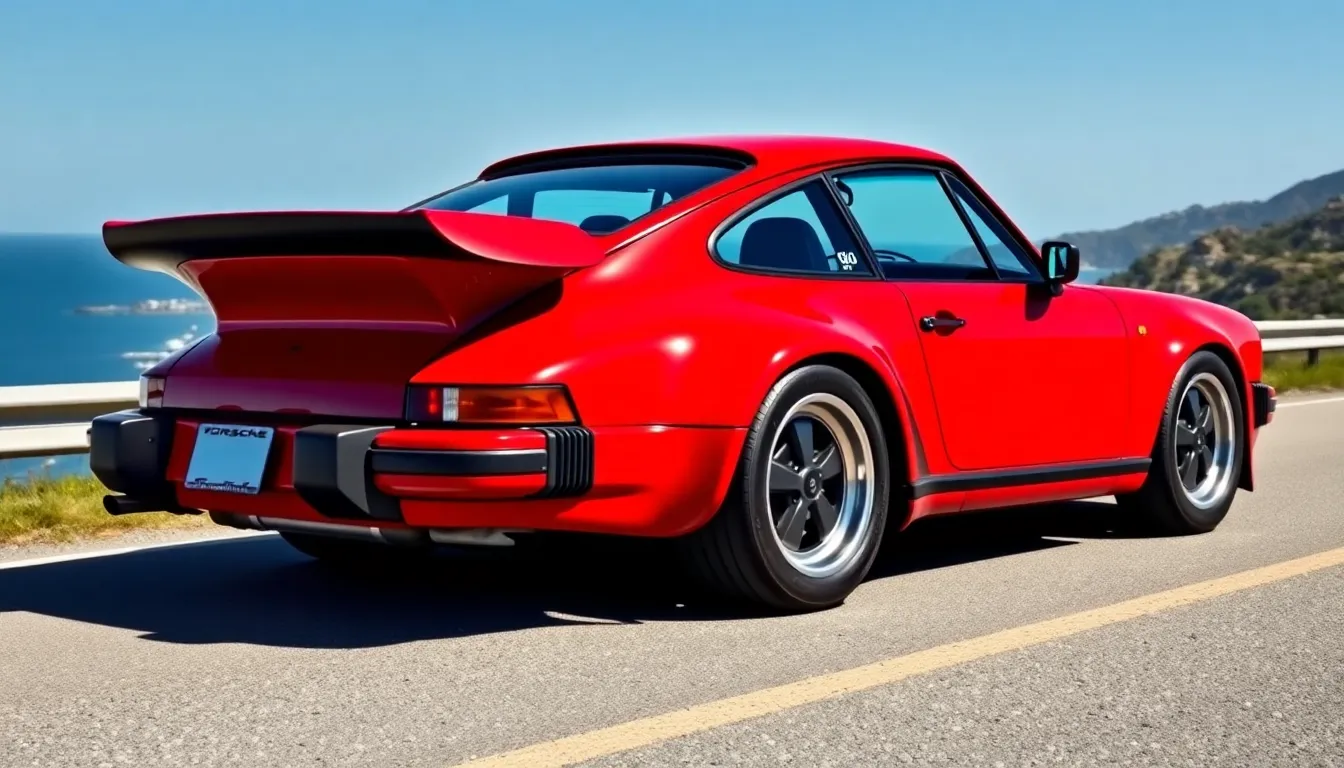
Design elements of the Porsche 930 Turbo create an unmistakable visual identity that separates it from standard 911 models. Aggressive styling cues communicate the car’s performance capabilities while maintaining Porsche’s classic proportions.
Exterior Design Elements
Wide rear fender flares accommodate 8-inch wheels and give the 930 Turbo its distinctive muscular stance. These flares extend 2.2 inches beyond standard 911 bodywork and create the car’s signature silhouette. The iconic whale tail spoiler rises prominently from the engine cover and houses the intercooler for the turbocharged engine.
Front and rear bumpers feature integrated black rubber sections that comply with 1970s safety regulations while adding visual weight to the design. Chrome accents highlight the window surrounds and door handles, contrasting against the body color options that include Guards Red, Grand Prix White, and Silver Metallic.
Fuchs wheels measure 7 inches wide at the front and 8 inches at the rear, creating a staggered setup that enhances the car’s aggressive appearance. Black window trim and side mirror housings provide subtle details that distinguish turbo models from naturally aspirated variants.
Door-mounted side mirrors feature a distinctive teardrop shape and sit higher than contemporary sports cars to improve visibility. The front air dam incorporates fog lights and creates additional downforce at speed while maintaining ground clearance for daily driving.
Interior Layout and Features
Black leatherette upholstery covers the standard seats, with optional full leather packages available in matching exterior colors. Sport seats feature pronounced side bolsters and integrate adjustable headrests for enhanced comfort during spirited driving.
Dashboard layout follows traditional Porsche design with five round gauges arranged in front of the driver. The boost gauge replaces the standard clock and displays turbocharger pressure readings up to 0.8 bar. Additional gauges monitor oil temperature and oil pressure to track engine health during performance driving.
Center console houses the gear shifter, handbrake, and basic controls for heating and ventilation systems. Radio placement sits in the dashboard center, with speakers mounted in the door panels for adequate sound quality.
Carpet colors coordinate with upholstery choices and feature Porsche script embroidery on the floor mats. Storage compartments include door pockets, glove box, and small bins behind the seats for essential items.
Three-spoke steering wheel measures 380mm in diameter and features the Porsche crest in the center hub. Optional wood-rim steering wheels provide enhanced grip and visual appeal for drivers seeking additional luxury touches.
Driving Experience and Ownership
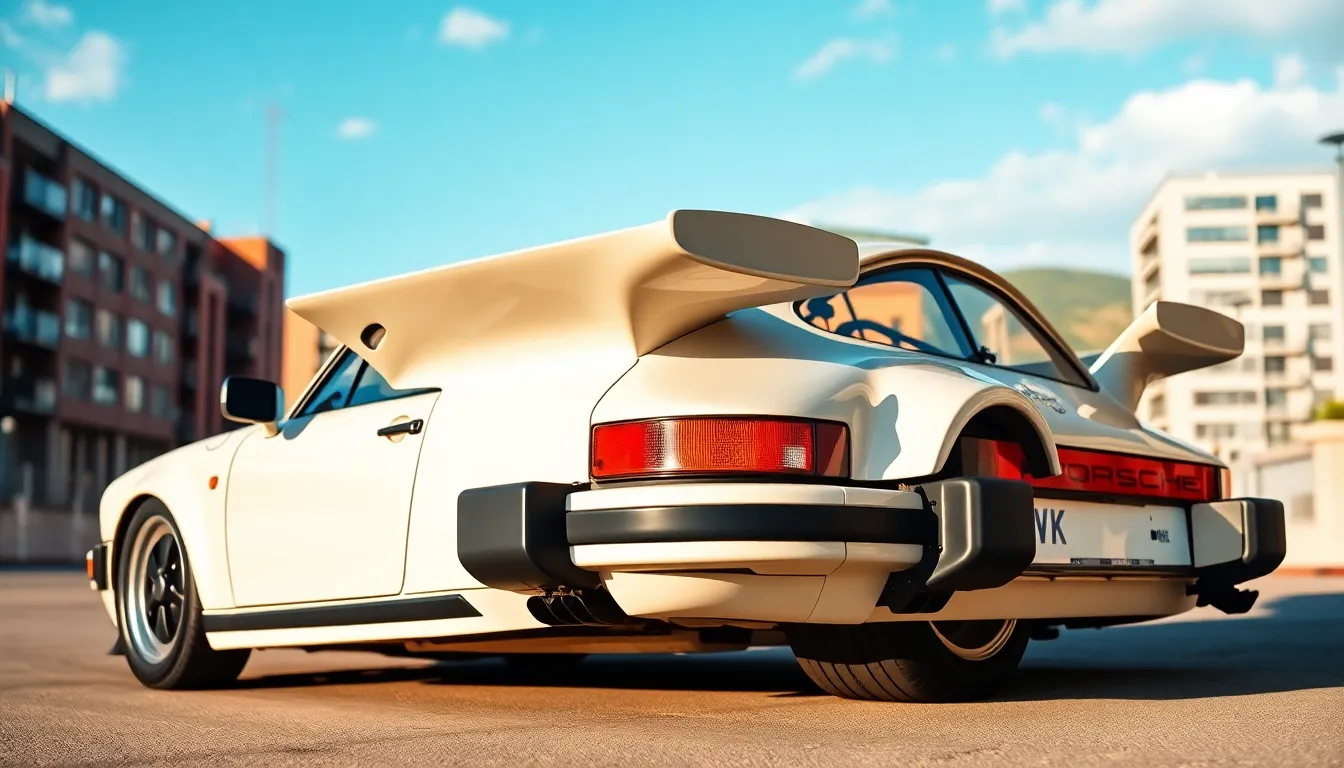
The Porsche 930 Turbo offers an uncompromising ownership experience that demands respect from drivers and dedication from owners. This legendary machine transforms every journey into an intense driving adventure while presenting unique challenges for daily use and maintenance.
Daily Drivability
Daily driving the 930 Turbo presents important challenges that separate it from modern sports cars. The turbocharged flat-six engine delivers power in sudden bursts after turbo lag builds boost pressure around 3,500 rpm. Clutch engagement requires precise foot control due to the heavy pedal feel and abrupt engagement point. City driving becomes particularly demanding when handling stop-and-go traffic with the aggressive clutch and firm suspension setup.
The rear weight bias creates unpredictable handling characteristics during wet weather conditions. Parking proves challenging with limited rearward visibility caused by the massive whale tail spoiler blocking the rear window view. Interior comfort suffers from firm sport seats and minimal sound deadening that transmits road noise and engine vibrations directly into the cabin.
Heat management becomes problematic during summer months when the air-cooled engine generates excessive cabin temperatures. The heating system produces intense warmth that can overwhelm occupants even during moderate weather conditions.
Maintenance and Reliability
Maintenance requirements for the 930 Turbo exceed typical sports car standards with specialized service needs and expensive parts. Engine rebuild intervals typically occur between 60,000 to 80,000 miles depending on driving conditions and maintenance history. The KKK K26 turbocharger requires replacement every 40,000 to 60,000 miles when boost pressure drops below optimal levels.
| Component | Service Interval | Average Cost |
|---|---|---|
| Engine rebuild | 60,000-80,000 miles | $25,000-$35,000 |
| Turbocharger replacement | 40,000-60,000 miles | $4,000-$6,000 |
| Transmission service | 30,000 miles | $1,200-$1,800 |
| Valve adjustment | 15,000 miles | $800-$1,200 |
Fuel system components deteriorate faster than naturally aspirated engines due to higher operating pressures and temperatures. Electrical systems show age-related failures in ignition components and fuel injection controllers that require specialized diagnostic equipment. Cooling system maintenance proves critical with regular inspection of oil coolers and intercooler efficiency.
Finding qualified technicians presents ongoing challenges as fewer mechanics possess expertise with air-cooled turbocharged engines. Parts availability continues declining with certain components requiring custom fabrication or sourcing from specialist suppliers at premium prices.
Market Value and Investment Potential
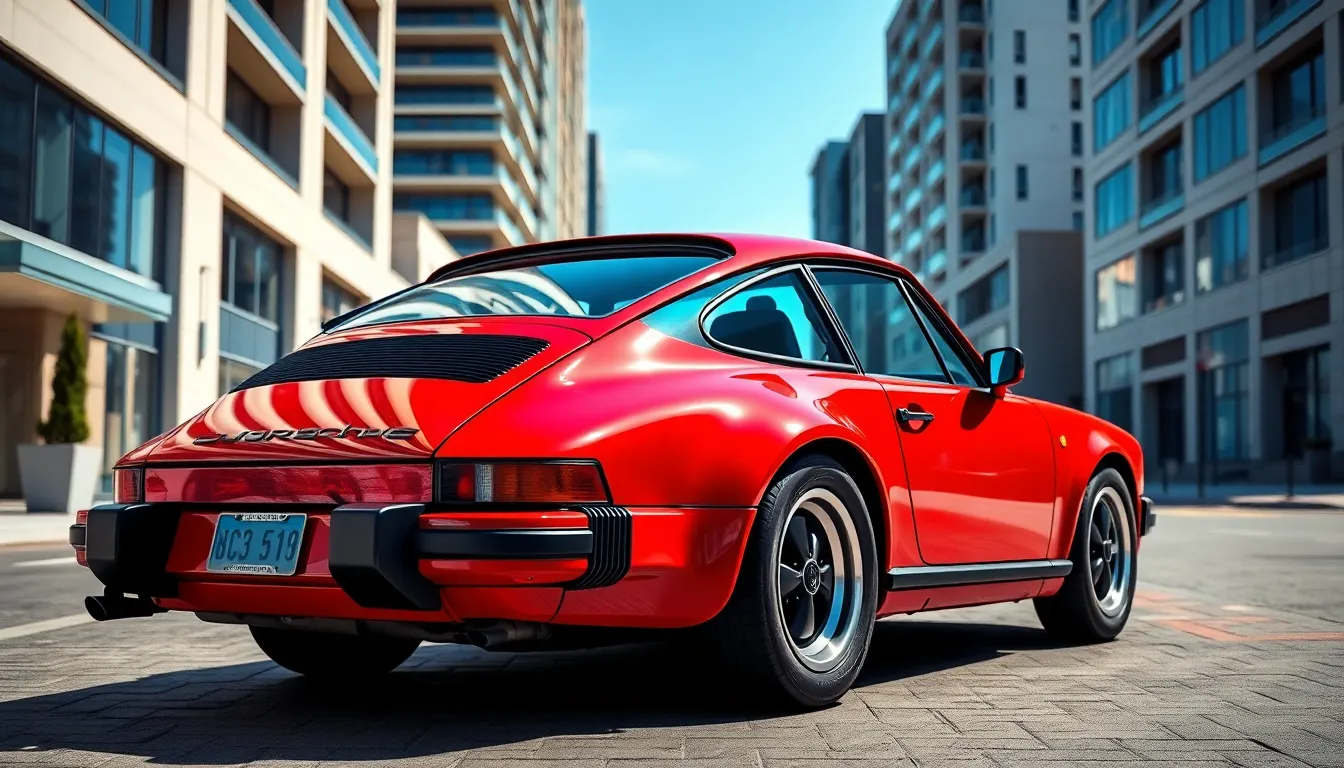
Market values for Porsche 930 Turbo models have experienced dramatic appreciation over the past decade. Collector car auction data from Barrett-Jackson and RM Sotheby’s shows average sale prices ranging from $85,000 to $350,000 depending on condition, mileage, and model year. Examples include a 1979 930 Turbo selling for $132,000 at Bonhams in 2023, while pristine low-mileage specimens regularly exceed $200,000.
Investment performance metrics demonstrate the 930 Turbo’s strength as a collectible asset. Hagerty Insurance reports average annual appreciation rates of 12-15% between 2015 and 2024 for well-maintained examples. Classic car investment funds like the Knight Frank Luxury Investment Index consistently rank the 930 Turbo among top-performing vintage Porsches.
| Model Year | Average Market Value | Condition Premium | Annual Appreciation |
|---|---|---|---|
| 1976-1977 | $125,000-$180,000 | +35% for Concours | 14.2% |
| 1978-1979 | $110,000-$160,000 | +25% for Excellent | 13.8% |
| 1986-1989 | $95,000-$145,000 | +40% for Original | 15.1% |
Production scarcity drives investment fundamentals for the 930 Turbo market. Only 21,589 units were manufactured across 14 years, with US market allocation representing approximately 8,500 cars. European specification models command premium pricing due to higher power output and original equipment differences.
Condition factors significantly impact valuation metrics for potential investors. Numbers-matching engines add 20-25% to base values, while comprehensive service records increase market appeal. Original paint and interior components create substantial premiums, particularly for early production years with unique color combinations like Guards Red and Martini Racing livery.
Geographic market variations affect 930 Turbo pricing across different regions. California examples often carry moisture damage risks but benefit from year-round driving climate preservation. East Coast cars face rust concerns that reduce values by 10-15% unless properly addressed through restoration. European imports typically offer better specifications but require DOT compliance modifications.
Future appreciation potential remains strong based on generational wealth transfer trends. Baby boomer collectors who experienced 930 Turbos during their youth continue driving demand, while Generation X buyers enter peak earning years. Limited production numbers ensure supply constraints that historically support price stability during economic downturns.
Ownership costs impact total investment returns for 930 Turbo buyers. Annual maintenance expenses average $3,500-$5,500 for driven examples, while storage and insurance add $2,000-$4,000 yearly. Major engine rebuilds cost $15,000-$25,000 every 60,000-80,000 miles, requiring budget planning for long-term ownership strategies.
Comparing the 930 Turbo to Modern Porsches

Modern Porsche models showcase dramatically different engineering philosophies compared to the raw 930 Turbo experience. Today’s 911 Turbo generates 640 horsepower from its twin-turbocharged 3.8-liter flat-six engine, nearly 2.5 times the 930’s 260 horsepower output. Contemporary turbocharging eliminates the vintage model’s notorious lag through variable geometry turbos and sophisticated engine management systems.
Performance metrics reveal the technological evolution between generations. Current 911 Turbo models accelerate from 0 to 60 mph in 2.7 seconds versus the 930’s 5.4-second benchmark. Top speeds increased from the original’s 155 mph to today’s electronically limited 198 mph capabilities. Quarter-mile times dropped from the 930’s 13.4 seconds to modern variants completing runs in 10.8 seconds.
| Performance Metric | 930 Turbo (1975-1989) | Modern 911 Turbo (2023) |
|---|---|---|
| Horsepower | 260 hp | 640 hp |
| 0-60 mph | 5.4 seconds | 2.7 seconds |
| Top Speed | 155 mph | 198 mph |
| Quarter Mile | 13.4 seconds | 10.8 seconds |
| Engine Size | 3.0L single turbo | 3.8L twin turbo |
Handling characteristics represent the most important transformation between eras. Advanced all-wheel-drive systems in contemporary models eliminate the 930’s rear-biased weight distribution challenges. Electronic stability programs, adaptive dampers, and torque vectoring create predictable cornering behavior that contrasts sharply with the vintage model’s demanding dynamics.
Technology integration separates modern Porsches from their analog predecessor by decades of innovation. Digital instrument clusters, infotainment systems, and driver assistance features replace the 930’s mechanical gauges and manual controls. Porsche Communication Management offers connectivity options that weren’t conceivable during the original Turbo’s production years.
Construction methods evolved from the 930’s galvanized steel monocoque to today’s mixed-material architectures incorporating aluminum and carbon fiber components. Weight distribution improved through strategic material placement and engineering refinements. Modern models achieve better power-to-weight ratios even though increased equipment and safety features.
Ownership experiences differ substantially between generations about maintenance demands and daily usability. Contemporary 911 Turbos feature extended service intervals of 10,000 miles compared to the 930’s 3,000-mile requirements. Reliability improvements reduce the vintage model’s frequent turbocharger and engine rebuild necessities.
Price positioning creates interesting market dynamics between classic and contemporary offerings. New 911 Turbo models start around $174,300 while pristine 930 Turbos command $200,000 to $350,000 at auction. Collector premiums for the vintage model often exceed modern alternatives’ depreciated values after several years.
Driving engagement levels favor different preferences depending on enthusiast priorities. Purists appreciate the 930’s unfiltered mechanical connection and challenging character traits. Modern buyers prioritize the current generation’s refinement, performance consistency, and technological conveniences over raw driving experiences.
Conclusion
The Porsche 930 Turbo stands as automotive royalty that’ll never lose its crown. We’ve witnessed how this legendary machine transformed from a feared “Widowmaker” into one of the most coveted collector cars on the planet.
Whether you’re drawn to its raw driving experience or see it as a solid investment opportunity the 930 Turbo delivers on both fronts. Its combination of rarity aggressive styling and unfiltered performance creates an ownership experience that modern cars simply can’t replicate.
For enthusiasts seeking automotive authenticity the 930 Turbo remains the ultimate choice. It’s not just a car—it’s a piece of motoring history that continues to captivate new generations of Porsche lovers worldwide.
Frequently Asked Questions
What is the Porsche 930 Turbo and why is it called the “Widowmaker”?
The Porsche 930 Turbo is a legendary sports car launched in 1975, featuring the first production turbocharged engine from Porsche. It earned the “Widowmaker” nickname due to its unpredictable handling characteristics, sudden power delivery, and turbo lag that made it extremely challenging to drive, especially during aggressive cornering. The car’s rear weight bias and abrupt power surge required exceptional driving skills to manage safely.
How much horsepower does the Porsche 930 Turbo produce?
The Porsche 930 Turbo generates 260 horsepower from its 3.0-liter turbocharged flat-six engine, along with 254 lb-ft of torque. This power output was achieved using a KKK K26 turbocharger system, making it one of the most powerful production cars of its era and establishing new performance standards in the supercar industry.
What are the performance specifications of the 930 Turbo?
The 930 Turbo accelerates from 0 to 60 mph in 5.4 seconds and achieves a top speed of 155 mph, making it one of the fastest production cars of 1975. These impressive performance figures were groundbreaking for the mid-1970s and demonstrated Porsche’s commitment to pushing the boundaries of automotive engineering and speed capabilities.
How many Porsche 930 Turbos were produced?
Only 21,589 units of the Porsche 930 Turbo were manufactured between 1975 and 1989, making it a relatively rare and exclusive vehicle. This limited production run contributes significantly to its desirability among collectors and helps explain its strong appreciation in value over the decades since production ended.
What makes the 930 Turbo’s design distinctive?
The 930 Turbo features aggressive styling elements including wide rear fender flares, the iconic whale-tail spoiler, integrated bumpers, and chrome accents. These design cues create an unmistakable muscular stance and visual identity that has become synonymous with 1980s supercar aesthetics, making it instantly recognizable even decades after production.
What is the current market value of a Porsche 930 Turbo?
Porsche 930 Turbo values range from $85,000 to $350,000 depending on condition, mileage, and provenance. Well-maintained models have shown annual appreciation rates of 12-15% over the past decade. Pristine examples can command $200,000 to $350,000 at auction, reflecting strong investment potential and collector demand for this iconic sports car.
What are the maintenance requirements for a 930 Turbo?
The 930 Turbo requires intensive maintenance, including engine rebuilds every 60,000-80,000 miles and turbocharger replacements every 40,000-60,000 miles. Additional specialized service needs and high-cost components make ownership expensive. Potential owners should budget significantly for maintenance costs, as the car’s complex turbocharged system demands regular professional attention and premium parts.
How does the 930 Turbo compare to modern Porsche 911 Turbos?
Modern 911 Turbos produce 640 horsepower from twin-turbocharged 3.8-liter engines and accelerate 0-60 mph in 2.7 seconds, compared to the 930’s 260 horsepower and 5.4-second time. Contemporary models feature all-wheel-drive, electronic stability systems, and eliminate turbo lag, offering predictable handling versus the 930’s challenging, raw driving experience that appeals to purists.
What are the challenges of daily driving a 930 Turbo?
Daily driving a 930 Turbo presents significant challenges including abrupt turbo power delivery, heavy clutch operation, and limited visibility due to the whale-tail spoiler. The car’s unpredictable handling characteristics, lack of modern safety features, and demanding driving dynamics make it unsuitable for inexperienced drivers or those seeking comfortable, predictable transportation.
Why is the Porsche 930 Turbo considered an important automotive icon?
The 930 Turbo revolutionized the sports car industry as the first production Porsche with turbocharging, establishing new performance benchmarks in 1975. Its combination of raw power, distinctive design, cultural significance as a symbol of 1980s excess, and limited production numbers have cemented its status as an automotive icon that continues to influence supercar design and captivate enthusiasts worldwide.

